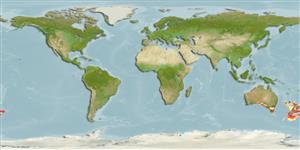Élasmobranches (requins et raies) (sharks and rays) >
Squaliformes (Sleeper and dogfish sharks) >
Oxynotidae (Rough sharks)
Etymology: Oxynotus: oxys (Gr.), sharp; notos (Gr.), back, referring to its keeled back (“dorso carenato”) (See ETYFish); bruniensis: -ensis, Latin suffix denoting place: the shore of Bruny Island, Tasmania, where holotype was discovered in a “dried … but fair state of preservation” (See ETYFish).
More on author: Ogilby.
Environment: milieu / climate zone / depth range / distribution range
Écologie
marin bathydémersal; profondeur 45 - 1070 m (Ref. 26346), usually 350 - 650 m (Ref. 6871). Deep-water; 31°S - 55°S, 125°E - 172°W (Ref. 54691)
Southwest Pacific: confined to temperate waters off southern Australia and New Zealand.
Length at first maturity / Taille / Poids / Âge
Maturity: Lm ?, range 60 - ? cm
Max length : 65.0 cm TL mâle / non sexé; (Ref. 122636); 74.0 cm TL (female); poids max. publié: 6.6 kg (Ref. 122636)
Description synthétique
Clés d'identification | Morphologie | Morphométrie
Épines anales: 0. Uniform grey-brown coloration; short, blunt snout; high sail-like dorsal fins with spines and broad apices, first dorsal spine inclined backward; high, thick triangular body with large, rough denticles; circular spiracles; lanceolate upper teeth, lower blade-like teeth in less than 12 rows (Ref. 247).
Found on outer continental and insular shelves and uppermost slopes (Ref. 247). Probably feeds on bottom invertebrates and fishes. Ovoviviparous (Ref. 205). Taken incidentally with bottom trawls but probably not used (Ref. 247).
Ovoviviparous, with 7 young in a litter (Ref. 247). Size at birth about 24 cm (Ref. 6871). Distinct pairing with embrace (Ref. 205).
Compagno, L.J.V., 1984. FAO Species Catalogue. Vol. 4. Sharks of the world. An annotated and illustrated catalogue of shark species known to date. Part 1 - Hexanchiformes to Lamniformes. FAO Fish. Synop. 125(4/1):1-249. Rome, FAO. (Ref. 247)
Statut dans la liste rouge de l'IUCN (Ref. 130435: Version 2024-2)
Menace pour l'homme
Harmless
Utilisations par l'homme
Pêcheries: sans intérêt
Outils
Articles particuliers
Télécharger en XML
Sources Internet
Estimates based on models
Preferred temperature (Ref.
123201): 6.2 - 10.4, mean 8 °C (based on 150 cells).
Phylogenetic diversity index (Ref.
82804): PD
50 = 0.5625 [Uniqueness, from 0.5 = low to 2.0 = high].
Bayesian length-weight: a=0.00372 (0.00163 - 0.00849), b=3.15 (2.94 - 3.36), in cm total length, based on LWR estimates for this (Sub)family-body shape (Ref.
93245).
Niveau trophique (Ref.
69278): 4.0 ±0.62 se; based on food items.
Résilience (Ref.
120179): Très faible, temps minimum de doublement de population supérieur à 14 ans (Fec=7).
Fishing Vulnerability (Ref.
59153): Moderate to high vulnerability (50 of 100).
Nutrients (Ref.
124155): Calcium = 8.32 [1.56, 44.88] mg/100g; Iron = 0.283 [0.065, 0.939] mg/100g; Protein = 18.8 [17.0, 20.6] %; Omega3 = 0.302 [0.100, 0.969] g/100g; Selenium = 14.1 [4.0, 44.8] μg/100g; VitaminA = 13.4 [2.6, 67.1] μg/100g; Zinc = 0.414 [0.198, 0.828] mg/100g (wet weight);
